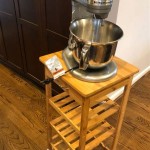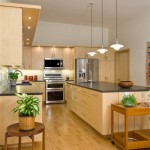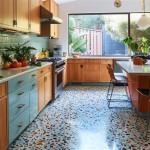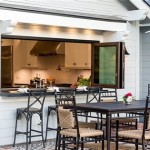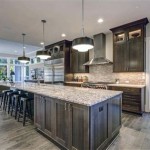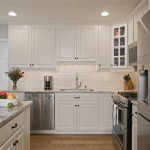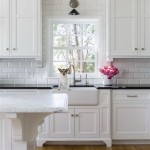Kitchen White Cabinets Blue Walls: A Timeless and Versatile Combination
The pairing of white cabinets and blue walls represents a classic and enduring design choice for kitchens. This combination offers a blend of brightness, tranquility, and versatility, making it suitable for a wide range of architectural styles and personal preferences. The success of this design lies in the contrast and complementary qualities of the two colors, creating an inviting and aesthetically pleasing space. Further exploration reveals the nuanced considerations necessary to achieve a harmonious and functional kitchen environment.
White cabinets are a perennial favorite in kitchen design due to their ability to reflect light and create a sense of spaciousness. This is particularly beneficial in smaller kitchens or those with limited natural light. White also provides a clean and neutral backdrop, allowing other elements in the kitchen, such as countertops, backsplash, and appliances, to take center stage. The color's neutrality allows for easy integration with various design styles, from traditional to contemporary.
Blue, on the other hand, introduces a calming and refreshing element. The color evokes feelings of serenity and stability, helping to create a relaxed atmosphere. The wide spectrum of blue hues offers considerable design flexibility. From light, airy shades to deep, saturated tones, blue can be adapted to suit different tastes and design goals. The choice of blue can significantly impact the overall mood and character of the kitchen.
The combination of these two colors is a safe bet when you consider adding different textures as well. Wooden countertops, marble backsplash or even stainless steel appliances can be added to further develop the style of the kitchen.
Understanding the Nuances of White Cabinet Selection
While white cabinets are often considered a straightforward choice, a variety of factors influence the overall aesthetic. The specific shade of white, the cabinet style, and the cabinet finish all contribute to the final look. Selecting the appropriate white requires careful consideration of the kitchen's lighting and existing architectural details.
Different shades of white have varying undertones. Some whites lean towards warm tones, with hints of yellow or cream, while others are cooler, with touches of gray or blue. Warm whites tend to create a cozier and more inviting atmosphere, while cool whites can create a more modern and minimalist look. Matching the white to the existing light in the kitchen is key. Natural sunlight tends to enhance warm whites, while artificial light can sometimes make cool whites appear sterile. Sampling different whites in the kitchen's lighting conditions before making a final decision is crucial.
Cabinet style also plays a significant role. Traditional kitchens often feature raised-panel or shaker-style cabinets with ornate detailing. These styles pair well with warmer whites and can contribute to a classic and elegant aesthetic. Contemporary kitchens, on the other hand, often feature flat-panel or slab-door cabinets with clean lines. These styles work well with cooler whites and contribute to a sleek and minimalist aesthetic. The architectural style of the home should guide the choice of cabinet style.
The cabinet finish affects both the appearance and durability of the cabinets. Matte finishes tend to absorb light, creating a softer and more subtle look. Glossy finishes reflect light, creating a brighter and more dramatic look. Semi-gloss finishes offer a balance between the two. Matte finishes are often preferred for traditional kitchens, while glossy finishes are often preferred for modern kitchens. The chosen finish should also be durable and easy to clean, as kitchens are high-traffic areas prone to spills and splatters.
Exploring the Spectrum of Blue Wall Paint Options
The choice of blue wall paint offers a vast range of possibilities, each with the potential to create a distinct ambiance. Factors such as the size of the kitchen, the amount of natural light, and the desired atmosphere should inform the selection process. Understanding the psychological effects of different blue hues can aid in creating a kitchen that is both aesthetically pleasing and emotionally resonant.
Light blues, such as sky blue or powder blue, can create an airy and spacious feel. These shades are particularly effective in smaller kitchens, as they help to visually expand the space. Light blues also contribute to a calming and serene atmosphere, making them ideal for kitchens where relaxation and tranquility are desired. They pair well with white cabinets, creating a clean and refreshing look. Sunlight usually accentuates light blues.
Medium blues, such as navy blue or denim blue, offer a more grounded and sophisticated look. These shades can add depth and character to a kitchen, creating a space that feels both stylish and inviting. Medium blues work well in larger kitchens, as they can help to balance the scale of the room. They also pair well with white cabinets, creating a striking contrast. Artificial lighting is often ideal for displaying medium blues.
Dark blues, such as indigo or charcoal blue, can create a dramatic and luxurious feel. These shades are best suited for kitchens with ample natural light, as they can make smaller spaces feel cramped and dark. Dark blues can add a sense of sophistication and elegance to a kitchen, creating a space that feels both refined and intimate. They pair well with white cabinets, creating a bold and eye-catching statement. It is often encouraged to use a variety of lighting to showcase dark blues.
Consider the undertones of the blue paint. Some blues have green undertones, while others have purple undertones. Green-toned blues tend to feel more natural and organic, while purple-toned blues tend to feel more sophisticated and elegant. Coordinating the undertones of the blue paint with the other elements in the kitchen, such as the countertops and backsplash, can help create a cohesive and harmonious design.
The sheen of the paint also affects the overall look. Matte finishes tend to absorb light, creating a softer and more subtle look. Glossy finishes reflect light, creating a brighter and more dramatic look. Eggshell or satin finishes offer a balance between the two. Kitchen walls typically require a durable and washable finish, so an eggshell or satin finish is often the best choice.
Integrating Hardware, Countertops, and Backsplash for a Cohesive Design
The selection of hardware, countertops, and backsplash materials is crucial for completing the cohesive look of a kitchen with white cabinets and blue walls. These elements should complement both the cabinetry and the wall color, creating a unified and visually appealing space. Careful consideration of materials, finishes, and textures is essential.
Hardware selection can significantly impact the overall style of the kitchen. For traditional kitchens, consider using brass or bronze hardware with ornate detailing. These finishes add warmth and character to the space. For contemporary kitchens, consider using stainless steel or chrome hardware with clean lines. These finishes add a sleek and modern touch. The scale of the hardware should also be considered. Larger pulls and knobs can make a statement, while smaller pulls and knobs offer a more subtle look. The selected hardware should be comfortable to grip and easy to clean.
Countertop materials offer a wide range of options, each with its own unique aesthetic and functional qualities. Granite countertops are a popular choice due to their durability and natural beauty. Marble countertops add a touch of luxury and elegance. Quartz countertops are a low-maintenance and durable option. Butcher block countertops add warmth and character. The chosen countertop material should complement both the white cabinets and the blue walls. Lighter countertops can help to brighten the space, while darker countertops can add contrast and depth. The edge profile of the countertop can also impact the overall look. A simple square edge offers a clean and modern look, while a more decorative edge adds a touch of elegance.
Backsplash materials offer an opportunity to add texture and visual interest to the kitchen. Subway tile is a classic and versatile choice. Glass tile adds a sleek and modern touch. Mosaic tile allows for creativity and personalization. Stone tile adds a natural and rustic feel. The chosen backsplash material should complement both the white cabinets and the blue walls. A lighter backsplash can help to brighten the space, while a darker backsplash can add contrast and depth. The pattern and texture of the backsplash can also impact the overall look. A simple pattern offers a clean and understated look, while a more complex pattern adds visual interest.
In addition, the layout of the backsplash is important. Adding a custom pattern or focal point can make a kitchen more unique and personal. For example, a vertical backsplash can visually lengthen the walls. Alternatively, a backsplash can follow the perimeter of the cabinets to add the feeling of a border.
Ultimately, the selection of hardware, countertops, and backsplash should be guided by the overall design goals and personal preferences. A cohesive and well-executed design will create a kitchen that is both aesthetically pleasing and functionally efficient.

Best Paint Colors For Kitchens With White Cabinets

10 Best Wall Colors To Go With White Kichen Cabinets

White Kitchen Cabinets Paired With Navy Walls Monk S In

Kitchen Paint Colors With White Cabinets

Best Wall Colors To White Kitchen Cabinets June 2025

94 Stylish And Inspiring Blue White Kitchens Digsdigs

The Classic White Kitchen La Salle Design Blog

Blue Kitchen Walls Design Ideas

Navy Blue Kitchen Wall White Cabinets Breadboard

Modern Farmhouse Kitchen Mcguire Co Bath

